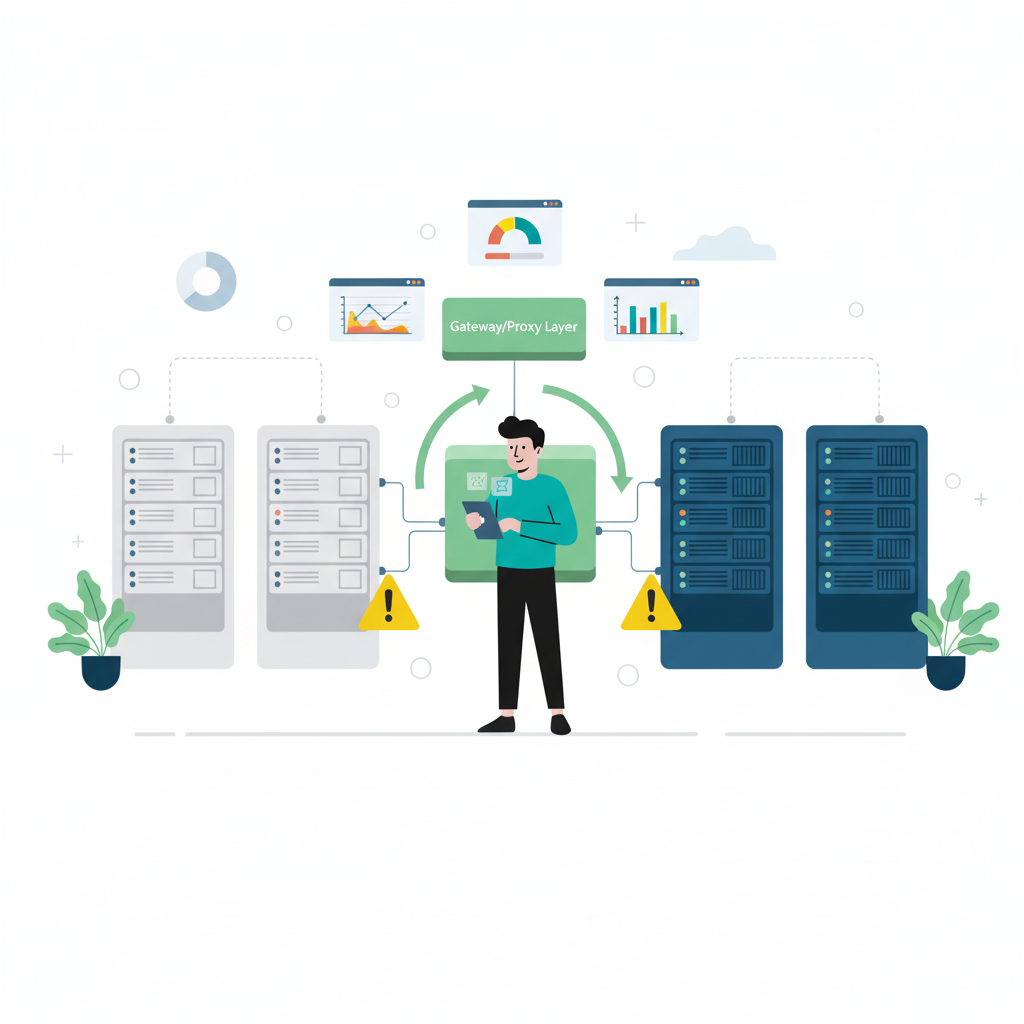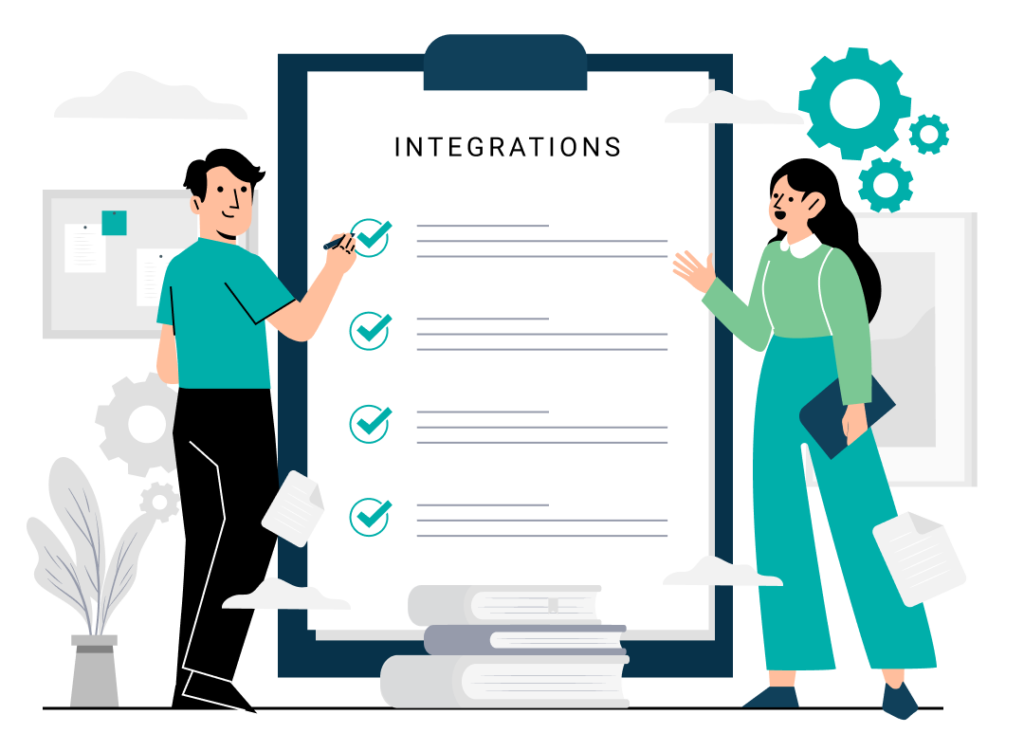Legacy systems drain resources and slow innovation, but replacing them risks business disruption. The strangler pattern offers a safer approach by gradually replacing legacy functionality through incremental migration. This comprehensive implementation guide is part of our complete guide to legacy system modernization and migration patterns, providing practical strategies for proxy layer configuration, traffic routing, and rollback procedures while maintaining business continuity and minimising risk through phased migration.
What is the Strangler Pattern and How Does It Work for Legacy System Migration?
The strangler pattern is a software migration strategy that incrementally replaces legacy system components by routing traffic through a proxy layer that gradually directs requests to new services while maintaining existing functionality. Named after the strangler fig tree, this pattern facilitates gradual, safe transition from legacy systems to modern architecture.
The pattern works through a proxy layer that intercepts incoming requests and routes them between legacy systems and new modules based on predefined rules. The proxy makes intelligent routing decisions, gradually directing more traffic to new services as they become available and proven reliable.
This approach suits scenarios where complete system replacement is too risky, costly, or impractical. Instead of replacing entire systems at once, teams build new functionality alongside existing applications, allowing incremental migration. The strangler pattern works particularly well when transitioning to microservices architecture and legacy system decomposition strategies, providing a controlled path for breaking down monolithic systems.
How Do I Set Up a Proxy Layer for Strangler Pattern Implementation?
A proxy layer acts as an intermediary that intercepts incoming requests and routes them to either legacy components or new services based on predefined routing rules and feature flags. Implementation can occur at application, API gateway, or network level depending on your architecture.
For most modern applications, API gateways provide comprehensive facade implementation with routing, transformation, and management capabilities. AWS API Gateway creates an API facade for on-premises applications, allowing new API resources under the same endpoint. Modern gateways support declarative routing rules, authentication, rate limiting, and monitoring.
For systems without existing API gateways, reverse proxies like NGINX or HAProxy implement simpler facades with basic routing.
Request-based routing directs traffic based on URL path, HTTP method, or query parameters. Content-based routing examines request content to determine destinations. User-based routing directs specific users to new implementations while keeping others on legacy systems.
Configuration involves setting up routing rules that examine request characteristics and determine whether legacy systems or new services should handle requests. Security considerations require authentication handling, encrypted communication, and proper access controls.
How Does the Strangler Pattern Differ from Big Bang Migration Approaches?
Strangler pattern minimises risk through gradual replacement while big bang migration replaces entire systems simultaneously, creating higher failure probability and extended downtime periods. This fundamental difference leads to different outcomes and risk profiles.
Big bang migration attempts to replace entire systems at once, often experiencing extended timelines, budget overruns, and high failure rates because it requires coordinating changes across all system components simultaneously.
The strangler pattern enables gradual, controlled transition from legacy to modern architecture without disruptive complete rewrite. This approach addresses big-bang migration risks by allowing teams to build new functionality alongside existing applications. For a detailed comparison of strangler pattern with other modernization approaches including rehosting, re-platforming, and refactoring, see our legacy system modernization fundamentals and strategic approaches guide. When planning your modernization strategy, our comprehensive guide to legacy system modernization and migration patterns provides the strategic framework for choosing the right approach for your organization’s specific needs.
Risk mitigation represents the most significant advantage. The pattern allows incremental replacement with changes made in small, manageable parts. Each change can be tested, validated, and rolled back independently, reducing potential issues. For comprehensive risk assessment frameworks and security considerations throughout your modernization journey, see our risk management and security framework for legacy system modernization guide.
Business continuity differs between approaches. Big bang migration typically requires extended downtime, while strangler pattern allows old systems to remain operational while new functionalities are gradually introduced, ensuring continuous operations.
What Are the Core Components Needed for Strangler Pattern Architecture?
Essential strangler pattern components include a proxy layer for traffic routing, anti-corruption layer for data translation, monitoring systems for observability, and rollback mechanisms for risk mitigation. These components work together to enable safe, incremental migration.
The facade serves as the interception point, routing requests to either legacy systems or new services based on functionality. API gateways often implement this facade, providing request routing, transformation, and protocol translation while handling authentication and monitoring.
Feature toggles provide runtime control over which implementation handles specific requests, enabling easy rollback if issues arise. These toggles allow dynamic switching between legacy and new implementations without code deployments.
Data synchronisation mechanisms ensure consistency when extracting functionality that modifies data. This becomes critical when both legacy and new systems access the same data during transition. The anti-corruption layer provides essential data format translation between systems.
Monitoring and observability systems track migration progress and system health throughout transition. These tools provide visibility into performance metrics, error rates, and user behaviour across both environments.
How Do I Create a Migration Plan for Strangler Pattern Implementation?
Create a phased migration plan by identifying functional boundaries, prioritising high-value low-risk components, establishing rollback procedures, and defining success metrics for each phase. Thoughtful planning lays the foundation for successful strangler implementations.
Start by identifying extraction candidates and dependencies through documenting API boundaries, data models, and transaction patterns. Map the application’s domain model to identify logical boundaries that align with business capabilities.
Domain-driven design helps identify bounded contexts that naturally segment systems. Identify clear boundaries based on business domains like billing, inventory, or customer management, technical subsystems like authentication or reporting, or external interfaces.
Use a phased approach, starting with less critical systems to minimise risk. Assess technical suitability of components for extraction, as functionality with minimal dependencies and clear interfaces offers easier starting points.
Understanding data dependencies and transaction patterns is crucial since these often present the greatest challenges. Components that modify shared data require careful planning to maintain consistency.
Develop priority matrix to select and sequence components based on business value, technical complexity, and risk factors. High-value, low-risk components should be prioritised for early phases to demonstrate success. When planning migration phases, consider how strangler pattern implementation integrates with cloud migration and hybrid infrastructure strategies to maximise modernization benefits.
What Monitoring and Observability Tools Are Needed During Migration?
Implement comprehensive monitoring covering legacy system performance, new service metrics, proxy layer health, data consistency checks, and user experience indicators to ensure migration success. Without strong monitoring, it’s impossible to know whether migration is succeeding.
Monitoring should cover system performance including response times, throughput, and error rates across both legacy and new systems. Infrastructure health monitoring encompasses CPU, memory, disk usage, and network performance during migration.
Observability should include distributed tracing, allowing teams to follow requests through both systems. This capability is essential for understanding performance bottlenecks and identifying issues spanning multiple components.
Centralised logging systems and real-time alerting ensure problems are detected early before impacting users. These systems should aggregate logs from all components including legacy systems, new services, proxy layers, and infrastructure.
Essential metrics include migration completion percentage, performance comparisons between systems, error rates, user satisfaction scores, and business continuity indicators. Close monitoring throughout migration is essential to quickly identify and address issues.
Performance testing validates new service capabilities under realistic load. Regression testing ensures system stability during transition, while canary release strategies enable controlled testing with limited user populations.
How Can I Minimize Business Disruption During Incremental Legacy Migration?
Minimise disruption through careful traffic splitting, comprehensive rollback procedures, thorough testing protocols, and continuous monitoring to ensure seamless user experience throughout migration. The strangler pattern allows old systems to remain operational while new functionalities are gradually introduced.
Traffic management strategies involve gradual rollout techniques that slowly increase the percentage of requests directed to new services. The proxy decides whether to handle requests using old systems or new services, decoupling user experience from underlying migration work.
Rollback procedure documentation and automation are essential for rapid recovery when issues arise. These procedures must be tested regularly and automated wherever possible to minimise recovery time. Every migration phase should include detailed rollback plans.
Testing frameworks should include comprehensive test suites covering functional, performance, security, and user acceptance testing. Testing should occur at development, staging, and production stages.
Feature toggles provide runtime control over system behaviour, allowing instant switching between old and new implementations without code deployments. These toggles are essential for maintaining business continuity when problems are discovered.
User experience monitoring ensures migration activities don’t negatively impact customer satisfaction. This monitoring should track key user journey metrics, transaction completion rates, and performance indicators affecting customer experience.
What Are the Best API Gateway Solutions for Small to Medium Businesses?
Popular SMB-friendly API gateway solutions include AWS API Gateway for cloud-native setups, Spring Cloud Gateway for Java environments, and Ocelot for .NET applications based on team expertise and infrastructure. The choice depends on technical requirements, team capabilities, and budget constraints.
AWS API Gateway provides a fully managed service that reduces operational complexity for teams with limited DevOps expertise. It offers comprehensive features including request routing, authentication, rate limiting, and monitoring. The managed nature means reduced infrastructure overhead, though costs can scale with usage.
Azure API Management offers similar capabilities for organisations invested in Microsoft technologies. It provides robust routing capabilities, developer portal functionality, and integration with Azure services. This solution works well for teams familiar with Microsoft stacks.
Spring Cloud Gateway serves Java-based organisations with existing Spring Framework expertise. It provides powerful routing capabilities, filter chains, and Spring ecosystem integration. This option offers more control but requires additional operational expertise.
Decision frameworks should consider team size, budget constraints, technical requirements, and existing infrastructure. Smaller teams with limited DevOps expertise benefit from managed solutions, while larger teams might prefer self-managed alternatives.
Implementation complexity involves evaluating setup time, configuration complexity, and ongoing maintenance requirements. Managed solutions typically offer faster time-to-value but may have higher costs. For detailed vendor evaluation criteria and implementation project management strategies, consult our project execution and vendor management for legacy modernization initiatives guide.
The strangler pattern provides a proven approach for incremental legacy migration while maintaining business continuity. For a comprehensive overview of all legacy modernization approaches and patterns, explore our complete guide to legacy system modernization and migration patterns to choose the right strategy for your organization.
FAQ
How long does a typical strangler pattern migration take for an SMB?
Migration timeline depends on system complexity and team resources, typically ranging from 6-18 months for small to medium applications with proper planning and phased execution.
Can I implement strangler pattern without dedicated DevOps expertise?
Yes, using managed services like AWS API Gateway or Azure API Management reduces operational complexity, though basic understanding of routing and monitoring remains essential.
What happens if new services fail during migration?
Rollback procedures automatically redirect traffic to legacy components while issues are resolved, ensuring business continuity and minimal user impact during problems.
How do I handle data synchronisation between old and new systems?
Implement anti-corruption layers and data synchronisation patterns to maintain consistency, using event-driven updates or scheduled synchronisation based on consistency requirements.
Is strangler pattern suitable for all types of legacy systems?
Strangler pattern works best for systems with clear functional boundaries and web-based interfaces, while tightly coupled monoliths may require additional decomposition preparation.
How much does strangler pattern implementation cost compared to rewrite?
Initial costs are lower due to gradual implementation, though total project cost depends on migration scope and timeline, typically 30-50% less than complete rewrites.
What security considerations apply during strangler pattern migration?
Maintain security through proxy layer authentication, encrypted inter-service communication, and regular security assessments of both legacy and new components throughout migration.
How do I measure success during strangler pattern implementation?
Track metrics including migration completion percentage, system performance improvements, defect rates, user satisfaction scores, and business continuity maintenance throughout the process.
Can I use strangler pattern for database migration?
Database migration requires careful planning with data synchronisation strategies, gradual schema evolution, and dual-write patterns to maintain consistency during transition periods.
What team skills are needed for successful strangler pattern implementation?
Teams need basic API gateway configuration, monitoring setup, and rollback procedure knowledge, though managed cloud services reduce technical complexity requirements significantly.
How do I handle third-party integrations during migration?
Manage integrations through the proxy layer, maintaining existing connections while gradually updating integration points and API contracts as new services replace legacy functionality.
What are common mistakes to avoid during strangler pattern implementation?
Avoid incomplete rollback planning, insufficient monitoring coverage, overly aggressive migration timelines, and neglecting data consistency requirements that can compromise business operations.












